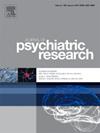Effects of varied rTMS frequencies on cognitive function in individuals with chronic schizophrenia: A double-blind randomized controlled trial
IF 3.7
2区 医学
Q1 PSYCHIATRY
引用次数: 0
Abstract
Background
Accumulating evidence has indicated the effects of repetitive transcranial magnetic stimulation (rTMS) on cognitive improvements in individuals with schizophrenia. However, the comparative effectiveness of low-frequency rTMS versus high-frequency rTMS on cognitive improvements remains unclear. This study aims to investigate the difference in the efficacy of low and high-frequency rTMS on cognitive function in chronic individuals with schizophrenia.
Methods
Ninety patients with chronic schizophrenia were randomly assigned to three groups: low-frequency (1Hz) rTMS group, high-frequency (10Hz) rTMS group, and sham group. rTMS treatment targeted the left dorsolateral prefrontal cortex was conducted for 4 weeks. Clinical symptoms were assessed using the Positive and Negative Syndrome Scale (PANSS), while cognitive function was measured with the Montreal Cognitive Assessment (MoCA) at baseline and the 4th week of treatment.
Results
Following the 4-week treatment, both low-frequency rTMS and high-frequency rTMS decreased PANSS negative symptoms while improving the MoCA subscales related to visuospatial/executive function and delayed memory. High-frequency rTMS demonstrated superiority over low-frequency rTMS in alleviating negative symptoms and enhancing delayed memory.
Conclusion
These findings suggest that rTMS is an effective approach for enhancing cognitive function in chronic schizophrenia. Furthermore, high-frequency rTMS emerges as more effective than low-frequency rTMS in improving negative symptoms and delayed memory.
Registration number
NCT03273439.
不同rTMS频率对慢性精神分裂症患者认知功能的影响:一项双盲随机对照试验
背景越来越多的证据表明,重复经颅磁刺激(rTMS)对精神分裂症患者的认知改善有影响。然而,低频rTMS与高频rTMS在认知改善方面的比较效果尚不清楚。本研究旨在探讨低频和高频rTMS对慢性精神分裂症患者认知功能的疗效差异。方法90例慢性精神分裂症患者随机分为低频(1Hz) rTMS组、高频(10Hz) rTMS组和假手术组。针对左背外侧前额叶皮质的rTMS治疗进行了4周。临床症状采用阳性和阴性综合征量表(PANSS)评估,认知功能在基线和治疗第4周采用蒙特利尔认知评估(MoCA)测量。结果经4周治疗后,低频rTMS和高频rTMS均减轻了PANSS阴性症状,改善了与视觉空间/执行功能和延迟记忆相关的MoCA亚量表。高频rTMS在缓解阴性症状和增强延迟记忆方面优于低频rTMS。结论rTMS是改善慢性精神分裂症患者认知功能的有效方法。此外,高频rTMS在改善阴性症状和延迟记忆方面比低频rTMS更有效。登记numberNCT03273439。
本文章由计算机程序翻译,如有差异,请以英文原文为准。
求助全文
约1分钟内获得全文
求助全文
来源期刊

Journal of psychiatric research
医学-精神病学
CiteScore
7.30
自引率
2.10%
发文量
622
审稿时长
130 days
期刊介绍:
Founded in 1961 to report on the latest work in psychiatry and cognate disciplines, the Journal of Psychiatric Research is dedicated to innovative and timely studies of four important areas of research:
(1) clinical studies of all disciplines relating to psychiatric illness, as well as normal human behaviour, including biochemical, physiological, genetic, environmental, social, psychological and epidemiological factors;
(2) basic studies pertaining to psychiatry in such fields as neuropsychopharmacology, neuroendocrinology, electrophysiology, genetics, experimental psychology and epidemiology;
(3) the growing application of clinical laboratory techniques in psychiatry, including imagery and spectroscopy of the brain, molecular biology and computer sciences;
 求助内容:
求助内容: 应助结果提醒方式:
应助结果提醒方式:


